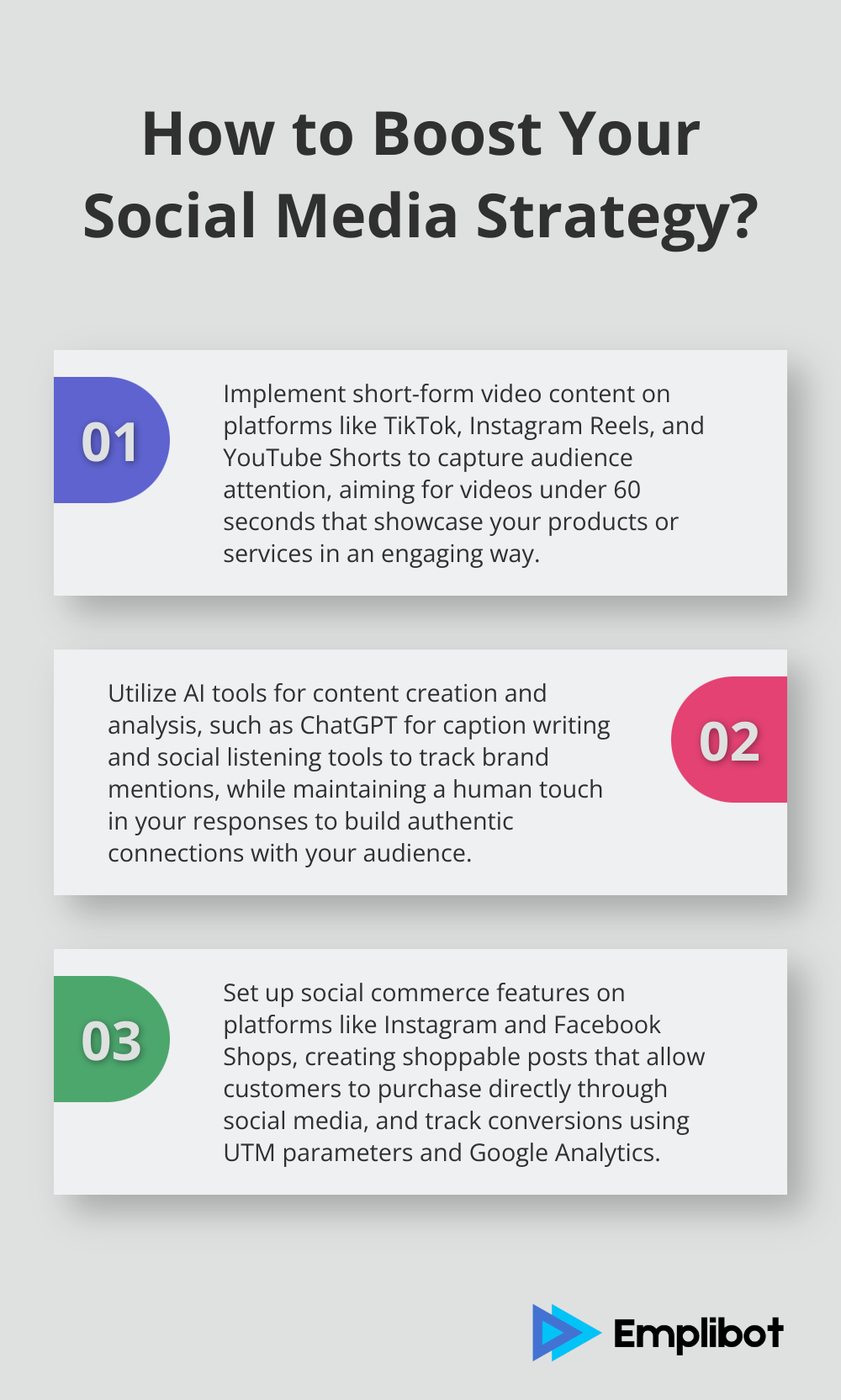Social media marketing for small business owners has become more complex and competitive than ever before. In 2024, staying ahead of the curve is essential for success in the digital landscape.
At Emplibot, we’ve seen firsthand how the right social media strategies can transform small businesses. This guide will equip you with practical, up-to-date tactics to boost your online presence and drive real results.
What’s New in Social Media for 2024?
Social media evolves rapidly, and 2024 brings significant changes. The landscape shifts towards more authentic, interactive content that connects with users on a personal level. Small businesses must adapt to these changes to stay competitive.
Platform Dominance and Demographics
Facebook maintains its giant status with 3.06 billion monthly active users as of the fourth quarter of 2023. TikTok, however, emerges as the rising star, with projections to surpass 2 billion users in 2024. Instagram continues to dominate visual content, especially for e-commerce, boasting over 3 billion monthly active users.

LinkedIn proves essential for B2B marketing. With over 1 billion members (60% aged 25 to 34), it serves as the primary platform for professional networking and content. Pinterest, often underestimated, attracts 482 million monthly users, with 80% of weekly users discovering new brands or products on the platform.
Video Takes the Crown
Short-form video content rules social media strategies. These videos engage 2.5 times more than longer videos, capturing 66% of consumers’ attention (HubSpot). This trend manifests in the success of TikTok and Instagram Reels.
YouTube Shorts, launched to compete with TikTok, already amasses 2 billion monthly active users. Small businesses can’t ignore this shift towards bite-sized, engaging video content in 2024.
AI and Automation: The Game Changes
AI tools revolutionize social media marketing. They enhance audience targeting, personalization, and analytics beyond mere content creation. For small businesses, this translates to more efficient and effective social media strategies.
AI creates tailored content, optimizes posting schedules, and provides insights once exclusive to large corporations with substantial marketing budgets. While AI tools like ChatGPT and DALL-E streamline content creation, maintaining a human touch remains important. Users crave authenticity, so blending AI efficiency with your unique brand voice yields the best results.
The Rise of Social Commerce
Social media platforms increasingly integrate shopping features, blurring the lines between social interaction and e-commerce. Instagram and Facebook Shops lead this trend, allowing businesses to sell products directly through their social media profiles.
Pinterest’s shoppable pins and TikTok’s partnership with Shopify further exemplify this shift. Small businesses should leverage these features to create seamless shopping experiences for their followers.
Emphasis on Social Responsibility
Consumers expect brands to take stands on social and environmental issues. In 2024, successful social media strategies will incorporate authentic messages about sustainability, diversity, and social responsibility.
Small businesses can showcase their values and initiatives through dedicated posts, behind-the-scenes content, and partnerships with relevant causes. This approach not only aligns with consumer expectations but also builds brand loyalty.
These trends shape the social media landscape, but success lies in understanding your specific audience and crafting a strategy that resonates with them. Next, we’ll explore how to create effective social media strategies tailored for small businesses in this dynamic environment.
How to Win at Social Media Marketing in 2024
Small businesses face unique challenges in social media marketing, but the right strategies can help you outperform larger competitors. Here’s how to make your mark in 2024:
Craft a Distinctive Brand Voice
Your brand voice is your social media fingerprint. It sets you apart in a sea of content. Define your brand’s personality traits first. Are you quirky? Professional? Compassionate? Create a style guide that outlines your tone, vocabulary, and emoji usage across all platforms.

A local bakery, for instance, might feature mouth-watering close-ups with playful captions on Instagram, while focusing on sustainable sourcing practices with a more formal tone on LinkedIn. Consistency across platforms builds trust and recognition.
Harness the Power of Your Customers
User-generated content (UGC) is marketing gold. It’s authentic, cost-effective, and builds community. Ask customers to share photos of your products in use or their experiences with your service. Create a branded hashtag and feature the best submissions on your profile.
UGC significantly influences brand awareness, engagement, and conversion rates. Set up a system to regularly collect and share customer testimonials. These real-world endorsements pack more punch than any ad copy you could write.
Embrace Video Content
If you haven’t jumped on the video bandwagon yet, now’s the time. Short-form videos reign supreme in 2024. TikTok’s explosive growth proves this point. Don’t worry if you’re camera-shy. Start small with behind-the-scenes glimpses of your business or quick product demos.
Live streaming creates a sense of urgency and allows real-time interaction with your audience. Host Q&A sessions, product launches, or virtual events. The key? Provide value and engage your viewers.
Listen and Respond
Social listening tools are invaluable for small businesses. They help you track mentions of your brand, industry trends, and competitor activity. Use this information to tailor your content strategy and address customer concerns proactively.
Community management goes hand-in-hand with social listening. Respond promptly to comments and messages. Most consumers (69%) want brands to respond within 24 hours, and 16% want a response within minutes. This level of engagement builds loyalty and can turn customers into brand advocates.
Social media isn’t just about broadcasting your message; it’s about building relationships. Engage in conversations, ask for feedback, and show the human side of your business.
These strategies will help small businesses create a robust social media presence that drives real results. It’s not about having the biggest budget; it’s about being smart, authentic, and consistent in your approach. Now, let’s explore how to measure and optimize your social media performance to ensure your efforts pay off.
How to Measure Social Media Success
Focus on Meaningful Metrics
Small businesses must track the right metrics to evaluate their social media performance effectively. In 2024, meaningful indicators of engagement and conversion take precedence over vanity metrics like follower count.
Engagement Rate: Content Impact Indicator
Engagement rate stands as the most telling metric for small businesses. It measures how well your content resonates with your audience. Calculate it by dividing the total number of interactions (likes, comments, shares) by your follower count, then multiplying by 100.

Industry benchmarks vary, but average engagement rates are 2.26% for Instagram and 1.54% for Facebook. LinkedIn averages lower, while TikTok can see higher rates. Monitor these rates closely to understand which content types drive the most interaction.
Conversion Rate: From Followers to Customers
Conversion rate directly impacts your bottom line. It measures the percentage of social media visitors who take a desired action (such as making a purchase or signing up for a newsletter).
Set up UTM parameters for your social media links to track conversions accurately. Google Analytics provides invaluable insights for this purpose. A good conversion rate varies by industry, but 2-5% is generally considered strong for social media traffic.
Return on Investment (ROI): Justifying Social Media Efforts
ROI quantifies the value of your social media marketing compared to its cost. Calculate it by subtracting your total investment from the revenue generated through social media, then dividing by the investment and multiplying by 100.
Calculating social media ROI involves defining goals, measuring metrics, tracking expenses, and using tools to simplify the process. This metric helps you allocate resources effectively and justify your social media budget.
Tools for Deeper Insights
While platform-native analytics offer basic insights, third-party tools provide more comprehensive data. Hootsuite and Sprout Social offer robust analytics and reporting features, allowing you to track metrics across multiple platforms in one dashboard.
For small businesses on a budget, Buffer provides a more affordable option with solid analytics capabilities. These tools not only save time but also offer deeper insights into your audience behavior and content performance.
A/B Testing: Continuous Improvement Strategy
A/B testing involves creating two versions of a post with a single variable changed (such as the image, caption, or call-to-action). By comparing the performance of these variants, you can optimize your content strategy over time.
Start with simple tests, like comparing different post times or caption lengths. As you gather data, move on to more complex variables like content themes or ad copy. Most social media management tools offer A/B testing features, making it easy to implement this strategy.
Final Thoughts
Social media marketing for small business owners in 2024 requires adaptability and strategic focus. Video content dominates platforms like TikTok and Instagram Reels, while AI transforms marketing approaches. A consistent brand voice across platforms, combined with user-generated content and customer testimonials, builds trust and authenticity.

Measuring performance through engagement rates, conversion rates, and ROI provides valuable insights into your efforts’ impact. Tools such as Hootsuite or Buffer offer deeper analytics, while A/B testing helps refine strategies. The social media landscape evolves rapidly, so staying informed about emerging trends and experimenting with new features is essential.
Emplibot offers a comprehensive solution for small business owners who feel overwhelmed by social media marketing complexities. It automates content creation and distribution across platforms, allowing you to maintain a strong online presence efficiently. Start implementing these strategies today to position your business for success in the digital landscape of 2024 and beyond.

